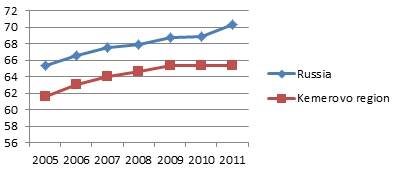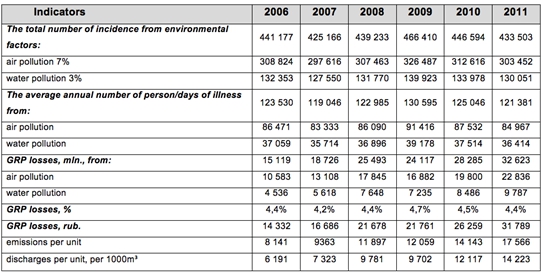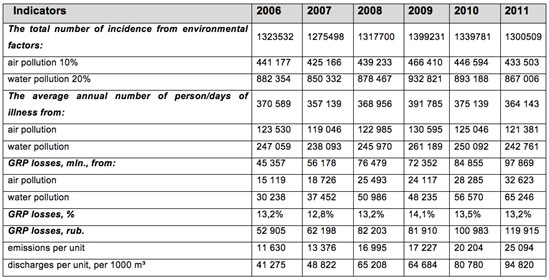ОЦЕНКА ЭКОНОМИЧЕСКОГО УЩЕРБА РЕГИОНА ОТ ЭКОЛОГИЧЕСКОГО ФАКТОРА НА ПРИМЕРЕ КЕМЕРОВСКОЙ ОБЛАСТИ
Елгина Ю.М.¹, Мекуш Г.Е.²
¹Аспирант, Кемеровский государственный университет; ² Доктор экономических наук, профессор, Кемеровский государственный университет
ОЦЕНКА ЭКОНОМИЧЕСКОГО УЩЕРБА РЕГИОНА ОТ ЭКОЛОГИЧЕСКОГО ФАКТОРА НА ПРИМЕРЕ КЕМЕРОВСКОЙ ОБЛАСТИ
Аннотация
В статье рассмотрено – качество здоровья населения региона, факторы, влияющие на устойчивое развитие населения, рассчитаны оценки потери ВРП от экологического фактора.
Ключевые слова: здоровье, экология, потери ВРП.
Yelgina Ju. M.¹, Mekush G.Ye.²
¹Postgraduate student, Kemerovo State University; ²PhD in economics, professor, Kemerovo State University
REGIONAL ECONOMIC LOSSES OF ENVIRONMENTAL IMPACTS ON THE EXAMPLE OF THE KEMEROVO REGION
Abstract
The article considers the quality of health in the region, the factors that affect the sustainable development of population; the GRP losses from environmental factors have been calculated.
Keywords: health, ecology, GRP losses.
Economic development of any country, region or individual household should ultimately be aimed at improving the quality of human life. Mining growth, increased production of goods and services, high volume of foreign capital investment or improvement of the state positions in international trade per se will be relative economic achievements only if the standard of living in the country in the future remains unchanged. In other words, if we do not improve the financial security of citizens, increase their life expectancy, reduce mortality, improve the availability and quality of education, increase cultural enlightenment and reduce the negative impact on the environment, the balanced development of the state will be impossible.
In 1992 twenty-seven basic principles of sustainable development of mankind were adopted as a part of practical realization of this idea. Nowadays these principles are the basis for the harmonious growth of any country or a particular region identifying key values and guidelines for balanced national strategies. In 2000 based on these principles and accumulated expertise the UN Millennium Declaration that included eight key Millennium Development Goals was signed. Half of them are associated with improved health (reducing child mortality, improving maternal health, combating HIV/AIDS) as well as ensuring environmental sustainability.
A large number of international experts and researchers think that it is human health and environmental quality that will play a crucial role in the sustainable development of mankind during the next few decades. Accordingly, the comprehensive approach to the analysis of dynamics of growth of any country or one of its regions is necessary not only to assess the achievements in the macroeconomic indicators but to take into account the changes in the values of various quality characteristics of people’s life. Currently the most universal indicator characterizing the quality of life of the country/region is the Human Development Index (HDI). One of the important indicators for the calculation of the HDI is the quantitative estimation of life expectancy. It assesses health, longevity and the average life expectancy at birth.
A cost analysis of the disease also becomes a more and more relevant direction now. It includes various methods of estimating the cost of the population morbidity. This direction implies a determination of the total economic burden of a particular disease for the society through the identification, measurement and assessment of direct and indirect costs. By analyzing the cost of illness government can calculate the cost of a disease in different cases, predict the volume of financing drug coverage, improve the social significance of the disease, justify the budgetary allocation to treatment, analyze which technologies help people improve their health. We can say that the macroeconomic assessment of morbidity is an important analysis, both for the country and for the region. It can show you the impact of industries on the environment and the impact of accumulated environmental problems on human health.
There are a large number of works of Russian and foreign authors that contain the research on the valuation of morbidity and mortality caused by environmental factors. The goals posed by researchers are the basis for differentiation of the works. The research was performed to assess the damage due to various types of impact: air pollution, water, noise and others. Estimates of damage to health included such pollutants as lead, mercury and others. A large number of works contain a research on assessment of damage to health in the cities and regions with tense ecological situation.
L.S. Sagdeieva (2012) analyzed the state of human potential on the example of the Kemerovo region, identified and substantiated the main directions for improvement of the quality of human capital in the region and assessed its adequacy for innovation development of economy in the region [1]. While assessing the quality of human potential the research also studied regional health indicators.
We should also mention a joint research of the University of Stuttgart and the Institute of Rational Use of Energy. They developed an “EcoSense” model that is an integrated software system designed to assess the impact of pollution on recipients. The methodology in this model was developed and used in such large environmental projects of EEU as ExternE and GARP. The “EcoSense” model was made specifically to assess the impact (risk) of air pollution on human health, agriculture (crop yield), building (construction) materials, etc. [2].
Ultimately, all the authors agree that community health is one of the most sensitive and priority indicators of the ecological situation in the state, a single region or town requiring regular monitoring and analysis. Nowadays this issue is extremely relevant for regions with tense ecological situation, where we need to create a model of management of the economic complex that could have not only a rational environmental management and maintenance of environmental quality but the increase of the quality of the human potential as well.
G.E. Mekush (2005) assessed the economic damage to health caused by environmental factors on the example of the Kemerovo region and analyzed the GRP losses in the area [2]. However, because of rapid changes in the statistical indicators of the region it is necessary to analyze new data on the regional health and environmental situation. With these new facts we can assess how the regional situation has changed and we can also compare it with the previous period as well as calculate the GRP losses under the current economic situation.
The quality of health and lifespan depends on various factors: natural, ecological and hygienic, and industrial but primarily - on socio-economic ones.

Fig.1- Comparison of life expectancy in Russia and Kemerovo region
Life expectancy in the Kemerovo region is about 5 years less than in Russia. It is economic life factors that significantly affect the community health. In 2013 the Kemerovo region was the 8th among all Russia’s regions in terms of industrial output, and the GDP level per capita is in the top twenty; however, as for the human development index Kuzbass ranks 34 [4]. Practically, this means that today high rates of regional economic growth are associated with high rates of pollution and land degradation, depletion of natural resources and the imbalance of the biosphere.
According to some forward-looking conclusions pro rata contribution of environmental pollution in the deterioration of the community health is over 60% in industrial cities and regions of Russia. Chemical air and water pollution, depletion of soil resources, contamination of food are associated with the pathology of the respiratory, digestive, endocrine and cardiovascular systems and immunodeficiency.
Morbidity and mortality findings were analyzed on the basis of the data from the Kemerovo Regional Health Department and the Kemerovo Regional Committee of State Statistics. Among the main causes of deaths in the region we can distinguish diseases of the circulatory system (48%), neoplasms (14%), and injuries and poisoning (14%). The number of deaths from infectious diseases per 100 000 people in our region are twofold higher than the average Russia’s ratio, the number of deaths from respiratory diseases being by 35% higher and those of the digestive system - by 55% of the Russia's total. However, if we compare the total mortality in the working-age population in the region in 2012 and 2007, it has decreased from 764 to 680 people (per 100 thousand residents) [4].
The analysis of overall morbidity showed that in the period of 2006 - 2011 this rate decreased by 4%, although it still remains high. In 2011 the main causes in the structure of incidence among children (0-14 years) were: respiratory diseases (50%), injuries and poisoning (7%), eye diseases (6%), diseases of the nervous system (6%), and infectious diseases (4%). In the structure of adolescents (15 to 17 years old) morbidity the leading diseases were: respiratory diseases (23%), eye diseases (18%), diseases of the musculoskeletal system (11%), injuries and poisoning (9%), diseases of the nervous system (6%). Among adults the leading diseases were those of the circulatory system (21%), the second ones - respiratory diseases (13%) followed by musculoskeletal system diseases (12%) and eye diseases (9%). The situation is almost identical to the above one in the structure of primary morbidity rate in different social groups [5].
Despite the fact that some of these diseases have a socio-behavioral character rather than environmental reasons the findings of medical examinations show a higher resistance of the human body to any disease (including those that do not have a direct relationship to the environment) in areas with favorable natural and climatic conditions.
The research includes macroeconomic assessment of damage to the region's economy from the impact of polluted environment on human health. Likewise the research of G.E. Mekush (2005) we calculated the amount of GRP losses using two variants: optimistic and pessimistic. Minimum levels of morbidity rates due to environmental factor were taken for an optimistic estimate and maximum levels - for the pessimistic ones; the data on water and air pollution were taken as well.
Although the incidence rate of the population from the environmental factor is gradually decreasing both in the optimistic and pessimistic scenario (tab. 1, 2), the macroeconomic analysis of the calculations shows that the incidence still cause enormous GRP losses from air and water pollution in the Kemerovo region. In the period analyzed the value of GRP losses due to emissions can be from 8,141 rubles up to 25,094 rubles and from 6,191 rubles to 94,820 rubles per 1,000m3 of discharges. Despite technological advances, the efforts of the authorities and public organizations, the load from man’s side to the environment is continuously growing. The situation is the same as 10 years ago. The region has irreversible processes in the form of violations in the natural ecosystems. The population is still bearing forced losses, for example purchases of clean water, preventive medication and treatment in hospital and outpatient units. There is still lack of awareness of this problem in the Kemerovo region; to reduce the impact on the environment we must change both personal and social values.
Thus, the economic policy in the region should not pursue only short-term goals of development: growth of production, increase of consumption, growth of employment. The problem of load on the environment should be one of the priorities for solutions in the future. The sustainable development must become the main purpose for our region. We have to develop technologies, change our behavior and have long-term perspective plans.
Table 1- An optimistic estimate of the GRP losses from environmental factors in the Kemerovo region
Table 2 - A pessimistic estimate of the GRP losses from environmental factors in the Kemerovo region 
Литература
- Сагдеева Л.С. Качество человеческого капитала как фактор социально экономического развития региона: Автореф. дис. канд. эконом. каук.- Кемерово, 2012.- 28 с.
- Мекуш Г.Е. Экологическая политика и устойчивое развитие: анализ и методические подходы / Г.Е. Мекуш; Под ред. С.Н. Бобылева. – М.: Экономика, 2011.- С. 160-193
- Федеральная служба государственной статистики: национальные счета [Электронный ресурс].- Режим доступа http://www.gks.ru/wps/wcm/connect/rosstat_main/rosstat/ru/statistics/accounts/ (дата обращения 15.01.2014)
- Елгина Ю.М. Социальные последствия экологических проблем в кемеровской области // Молодежь и наука. Реальность и будущее. – 2013.- С. 259-263.
- Показатели здравоохранения области 2009-2011. – Кемеровостат: Кемерово, 2011.- С. 3-15.
